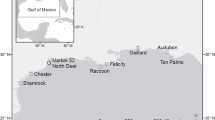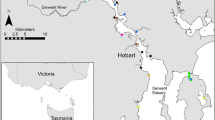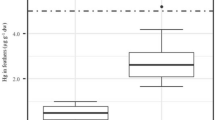Abstract
Levels of mercury and other contaminants should be lower in birds nesting on isolated oceanic islands and at high latitudes without any local or regional sources of contamination, compared to more urban and industrialized temperate regions. We examined concentrations of arsenic, cadmium, chromium, lead, manganese, mercury and selenium in the eggs, and the feathers of fledgling and adult glaucous-winged gulls (Larus glaucescens) nesting in breeding colonies on Adak, Amchitka, and Kiska Islands in the Aleutian Chain of Alaska in the Bering Sea/North Pacific. We tested the following null hypotheses: 1) There were no differences in metal levels among eggs and feathers of adult and fledgling glaucous-winged gulls, 2) There were no differences in metal levels among gulls nesting near the three underground nuclear test sites (Long Shot 1965, Milrow 1969, Cannikin 1971) on Amchitka, 3) There were no differences in metal levels among the three islands, and 4) There were no gender-related differences in metal levels. All four null hypotheses were rejected at the 0.05 level, although there were few differences among the three test sites on Amchitka. Eggs had the lowest levels of cadmium, lead, and mercury, and the feathers of adults had the lowest levels of selenium. Comparing only adults and fledglings, adults had higher levels of cadmium, chromium, lead and mercury, and fledglings had higher levels of arsenic, manganese and selenium. There were few consistent interisland differences, although levels were generally lower for eggs and feathers from gulls on Amchitka compared to the other islands. Arsenic was higher in both adult feathers and eggs from Amchitka compared to Adak, and chromium and lead were higher in adult feathers and eggs from Adak compared to Amchitka. Mercury and arsenic, and chromium and manganese levels were significantly correlated in the feathers of both adult and fledgling gulls. The feathers of males had significantly higher levels of chromium and manganese than did females. The levels of most metals in feathers are below those known to be associated with adverse effects in the gulls or their predators. However, levels of mercury in some gull eggs are within a range suggesting that several eggs should not be eaten in one day by sensitive humans.
Similar content being viewed by others
References
AFSC (Alaska Fisheries Science Center) (2006). Alaska fisheries; 2003. Available at: wysiwyg://www/afsc/noaa.gov/species/pollock.htm. (Accessed 25 May 2006).
ATSDR (2004). Public health assessment: Naval Air Facility, Adak. http://www.atsdr.cdc.vog/HAC/PHA/adak/ada_p1.html (accessed January 1, 2006).
Bargagli, R., Monaci, F., Sanchez-Hernandez, J. C., & Cateni, D. (1998). Biomagnification of mercury in an Antarctic marine coastal food web. Marine Ecology Progress Series, 169, 65–76.
Becker, P. (1992). Egg mercury level decline with the laying sequence in charadriiformes. Bulletin of Environmental Contamination and Toxicology, 48, 762–767.
Braune, B. W. (1987). Comparison of total mercury levels in relation to diet and molt for nine species of marine birds. Archives of Environmental Contamination and Toxicology, 16, 217–224.
Braune, B. M. (2007). Temporal trends of organochlorines and mercury in seabird eggs from the Canadian Arctic. 1975–2003. Environmental Pollution, 148, 599–613.
Braune, B. W., & Gaskin, D. E. (1987). Mercury levels in Bonaparte’s gull (Larus Philadelphia) during autumn molt in the Quoddy region, New Brunswick, Canada. Archives of Environmental Contamination and Toxicology, 16, 539–549.
Braune, B. W., Donaldson, G. M., & Hobson, K. A. (2002). Contaminant residues in seabird eggs from the Canadian Arctic. II. Spatial trends and evidence from stable isotopes for intercolony differences. Environmental Pollution, 117, 133–145.
Braune, B. W., Outridge, P. M., Fisk, A. T., Muir, D. C. G., Helm, P. A., Hobbs, K., Hoekstra, P. F., Kuzyk, Z. A., Kwan, M., Letcher, R. J., Lockhart, W. L., Norstrom, R. J., Stern, G. A., & Stirling, I. (2005). Persistent organic pollutants and mercury in marine biota of the Canadian Arctic: an overview of spatial and temporal trends. Science of the Total Environment, 351–352, 4–56.
Braune, B. W., Mallory, M. L., & Gilchrist, H. G. (2006). Elevated mercury levels in a declining population of ivory gulls in the Canadian Arctic. Marine Pollution Bulletin, 52, 969–987.
Burger, J. (1993). Metals in avian feathers: bioindicators of environmental pollution. Reviews in Environmental Toxicology, 5, 203–311.
Burger, J. (1994). Heavy metals in avian eggshells: another excretion method. Journal of Toxicology and Environmental Health, 41, 207–220.
Burger, J. (1996). Heavy metal and selenium levels in feathers of Franklin’s gulls in interior North America. Auk, 113, 399–407.
Burger, J. (2002). Food chain differences affect heavy metals in bird eggs in Barnegat Bay, New Jersey. Environmental Research, 90, 33–39.
Burger, J., Gaines, K. F., & Gochfeld, M. (2001). Ethnic differences in risk from mercury among Savannah River fishermen. Risk Anal., 21, 533-544.
Burger, J., & Gochfeld, M. (1991). Cadmium and lead in common terns (Aves: Sterna hirundo): relationship between levels in parents and eggs. Environmental Monitoring and Assessment, 16, 253–258.
Burger, J., & Gochfeld, M. (1996a). Heavy metal and selenium levels in Franklin’s Gull (Larus pipixcan) parents and their eggs. Archives of Environmental Contamination and Toxicology, 30, 487–491.
Burger, J., & Gochfeld, M. (1996b). Family: Laridae (gulls). In J. Del Hoya, A. Elliott, & J. Sargatal (Eds.), Handbook of birds of the world, vol. 3. Barcelona, Spain: Lynx Edicions.
Burger, J., & Gochfeld, M. (1997a). Risk, mercury levels, and birds: relating adverse laboratory effects to field biomonitoring. Environmental Research, 75, 160–172.
Burger, J., & Gochfeld, M. (1997b). Age differences in metals in the blood of herring (Larus argentatus) and Franklin’s (Larus pipixcan) gulls. Archives of Environmental Contamination and Toxicology, 33, 436–440.
Burger, J., & Gochfeld, M. (2000a). Metals in albatross feathers from midway atoll: influence of species, age, and nest location. Environmental Research, 82, 207–221.
Burger, J., & Gochfeld, M. (2000b). Effects of lead on birds (Laridae): a review of laboratory and field studies. Journal of Toxicology and Environmental Health, 3, 59–78.
Burger, J., & Gochfeld, M. (2000c). Metal levels in feathers of 12 species of seabirds from midway atoll in the northern Pacific Ocean. Science of the Total Environment, 257, 37–52.
Burger, J., & Gochfeld, M. (2002). Effects of chemicals and pollution on seabirds. In E. A. Schreiber, & J. Burger (Eds.), Biology of marine birds (pp. 485–525). Boca Raton, FL: CRC Press.
Burger, J., & Gochfeld, M. (2004). Metal levels in eggs of common terns (Sterna hirundo) in New Jersey: temporal trends from 1971 to 2002. Environmental Research, 94, 336–343.
Burger, J., & Gochfeld, M. (2007). Metals and radionuclides in birds and eggs from Amchitka and Kiska Islands in the Bering Sea/Pacific Ocean ecosystem. Environmental Monitoring and Assessment, 127(1–3), 105–117.
Burger, J., & Gochfeld, M. (2008). Mercury and other metals in feathers of common eider (Somasteria mollissima) and tufted puffins (Fratercula cirrhata) from the Aleutian Chain of Alaska. Archives of Environmental Contamination and Toxicology (in press).
Burger, J., & Peakall, D. (2003). Methodologies for assessing exposure to metals: speciation, bioavailability, and ecological host factors. Ecotoxicology and Environmental Safety, 56, 110–121.
Burger, J., Gochfeld, M., Kosson, D., Powers, C. W., Friedlander, B., Eichelberger, J., Barnes, D., Duffy, L. K., Jewett, S. C., & Volz, C. D. (2005). Science, policy, and stakeholders: developing a consensus science plan for Amchitka Island, Aleutians, Alaska. Environmental Management, 35, 557–568.
Burger, J., Gochfeld, M., Kosson, D. S., & Powers, C. W. (2006a). Biomonitoring for ecosystem and human health protection at Amchitka Island. Piscataway, NJ: CRESP.
Burger, J., Jewett, S., Gochfeld, M., Hoberg, M., Harper, S., Chenelot, H., Jeitner, C., & Burke, S. (2006b). Can biota sampling for environmental monitoring be used to characterize benthic communities in the Aleutians? Science of the Total Environment, 369, 393–402.
Coyle, J. J., Ingersoll, D. R., Fairchild, C. G., & May, T. W. (1993). Effects of dietary selenium on the reproductive success of bluegills (Lepomis macrochirus). Environmental Toxicology and Chemistry, 12, 551–565.
Custer, T. W., & Hoffman, W. L. (1994). Trace elements in canvasback (Aytha valisineria) wintering in Louisiana, USA, 1987–1988. Environmental Pollution, 84, 253–259.
DeBacker, V., Schiettecatte, L.-S., Jauniaux, T., & Bouquegneau, J.-M. (2001). Influence of age, sex, and body condition on zinc, copper, cadmium and metallothioneins in common guillemots (Uria aalga)stranded at the Belgian coast. Marine Environmental Research, 52, 427–444.
Eisler, R. (1985). Cadmium hazards to fish, wildlife and invertebrates: a synoptic review. Washington D.C: U.S. Fish & Wildlife Service. Biological Report 85 (1.2).
Eisler, R. (1987). Mercury hazards to fish, wildlife and invertebrates: a synoptic review. Washington DC: U.S. Department of Interior, Biological Report 85 (1.10).
Eisler, R. (1985). Cadmium hazards to fish, wildlife, and invertebrates: A synoptic review. Washington DC: U.S. Fish and Wildlife Service Rep. 85 (1.2).
Eisler, R. (1988). Lead hazards to fish, wildlife, and invertebrates: a synoptic review. Washington, DC: U. S. Fish and Wildlife Service.
Environmental Protection Agency (EPA) (2001). Methylmercury fish tissue criterion: Fish tissue criterion for methylmercury to protect human health http://www.epa.gov/waterscience/criteria/methylmercury/factsheet.html. Accessed June 10, 2008.
EPA (Environmental Protection Agency) (2004). National listing of fish advisories’ Cincinnati, Ohio: U.S. Environmental Protection Agency, available at http//map1.epa.gov (accessed 30 October 2004).
Food and Drug Administration (U.S. FDA) (2001). FDA consumer advisory. Available: http://www.fda.gov/bbs/topics/ANSWERS/2000/advisory.html. Washington, D.C.: U.S. Food and Drug Administration (accessed 1 December 2001).
Fimreite, N. F., Brevik, F., & Trop, R. (1982). Mercury and organochlorine in eggs from a Norwegian gannet colony. Archives of Environmental Contamination and Toxicology, 28, 58–60.
Fish & Wildlife Service (2004). Alaska Subsistence Spring/summer Migratory Bird Harvest. Anchorage, AK: U.S. Fish & Wildlife Service.
Fitzgerald, W. F. (1989). Atmospheric and oceanic cycling of mercury. In J. P. Riley, & R. Chester (Eds.), Chemical oceanography, vol. 10 (pp. 151–186). New York: Academic Press.
Food and Drug Administration (FDA) (1994). Mercury in fish: Cause for concern. FDA Consumer Magazine (September). http://www.fda.gov/fdac/reprints/mercury.html. Accessed June 11, 2008.
Furness, R. W. (1993). Birds as monitors of pollutants. In R. W. Furness, & J. J. D. Greenwood (Eds.), Birds as monitors of environmental change (pp. 86–143). London UK: Chapman & Hall.
Furness, R. W., & Rainbow, P. S. (1990). Heavy metals in the marine environment. Boca Raton, FL: CRC Press.
Furness, R. W., & Camphyuysen, K. C. J. (1997). Seabirds as monitors of the marine environment. ICES Journal of Marine Science, 54, 726–23.
Furness, R. W., Muirhead, S. J., & Woodburn, M. (1986). Using bird feathers to measure mercury in the environment: relationship between mercury content and moult. Marine Pollution Bulletin, 17, 27–37.
Ginsberg, G. L., & Toal, B. F. (2000). Development of a single-meal fish consumption advisory for methylmercury. Risk Analysis, 20, 41–47.
Gochfeld, M. (1980). Mercury levels in some seabirds of the Humboldt Current, Peru. Environmental Pollution A, 22, 197–205.
Gochfeld, M., Belant, J. L., Shukla, T., Benson, T., & Burger, J. (1996). Heavy metals in laughing gulls: gender, age and tissue differences). Environmental Toxicology and Chemistry, 15, 2275–2283.
Goede, A. A., & deBruin, M. (1984). The use of bird feather parts as a monitor for metal pollution. Environmental Pollution, 8, 281–289.
Goede, A. A., & deBruin, M. (1986). The use of feathers for indicating heavy metal pollution. Environmental Monitoring and Assessment, 7, 249–256.
Hamrick, K., & Smith, J. (2003). Subsistence food use in Unalaska and Nikolski. Anchorage, Alaska: Aleutian Pribilof Island Association.
Houghton, J. T., Callander, B. A., & Varney, S. K. (1992). Climate change 1992. Cambridge, UK: Cambridge University Press.
Hunter, B. A., & Johnson, J. G. (1982). Food chain relationships of copper and cadmium in contaminated grassland ecosystems. Oikos, 38, 108–117.
Irons, D. B., Anthony, R. G., & Estes, J. A. (1986). Foraging strategies of glaucous-winged gulls in a rocky intertidal community. Ecology, 67, 1460–1474.
Kenyon, K. W. (1961). Birds of Amchitka Island, Alaska. Auk, 78, 305–326.
Kim, E. Y., Murakami, T., Saeki, D., & Tatsukawa, R. (1996). Mercury levels and its chemical form in tissues and organs of seabirds. Archives of Environmental Contamination and Toxicology, 30, 259–266.
Lemly, D. A. (1993). Guidelines for evaluating selenium data from aquatic monitoring and assessment studies. Environmental Monitoring and Assessment, 28, 83–100.
Lewis, S. A., & Furness, R. W. (1991). Mercury accumulation and excretion by laboratory reared black-headed gulls (Larus ridibundus) chicks. Archives of Environmental Contamination and Toxicology, 21, 316–320.
Mailman, R. B. (1980). Heavy metals. In J. J. Perry (Ed.), Introduction to environmental toxicology (pp. 34–43). New York: Elsevier.
Merritt, M. L., & Fuller, R. G. (Eds.), (1977). The environment of Amchitka Island, Alaska. U.S. Report NVO-79, Technical Information Center, Energy Research and Development Administration, Washington DC.
Metcheva, R., Yurukova, L., Teodorova, S., & Nikolova, E. (2006). The penguin feathers as bioindicator of Antarctic environmental state. Environmental Monitoring and Assessment, 362, 259–265.
Monteiro, L. R. (1996). Seabirds as monitors of mercury in the marine environment. Water, Air, Soil Pollution, 80, 851–870.
Monteiro, L. R., & Furness, R. W. (1995). Seabirds as monitors of mercury in the marine environment. Water, Air, Soil Pollution, 80, 831–870.
NOAA (National Oceanic and Atmospheric Administration) (2004). Dutch Harbor — Unalaska, in Alaska, Top U.S Port for landings in 2003. NOAA report 04-096. Available at: www.nmfs.noaa.gov/docs/04-096_top_ports.pdf. Accessed 26 May 2006.
Nygard, T., Lie, E., Roy, N., & Steinnes, E. (2001). Metal dynamics in an Antarctic food chain. Marine Pollution Bulletin, 42, 598–602.
Patrick, R. (2002). How local Alaska native communities view the Amchitka issue. In Proceedings of the Amchitka Long-term Stewardship Workshop. Fairbanks, AK: CRESP/University of Alaska.
Peakall, D. B. (1992). Animal biomarkers as pollution indicators. London, UK: Chapman & Hall.
Powers, C. W., Burger, J., Kosson, D., Gochfeld, M., & Barnes, D. (2005). Biological and geophysical aspects of potential radionuclide exposure in the Amchitka marine environment. Piscataway, NJ: CRESP.
Rocque, D. A., & Winker, K. (2004). Biomonitoring of contaminants in birds from two trophic levels in the North Pacific. Environmental Toxicology and Chemistry, 23, 759–766.
SAS (Statistical Analysis System) (1995). SAS users’ guide. Cary, NC: SAS Institute.
Spry, D. J., & Wiener, J. G. (1991). Metal bioavailability and toxicity to fish in low-alkalinity lakes: a critical review. Environmental Pollution, 71, 243–304.
Stewart, F. M., Phillips, R. A., Catry, P., & Furness, R. W. (1997). Influence of species, age and diet on mercury concentrations in Shetland seabirds. Marine Ecology Progress Series, 151, 237–244.
Schiefler, R., Gauthier-Clerc, M., LeBohec, C., Crini, N., Coeurdassier, M., Badot, P.-M., Giraudous, P., & LeMaho, Y. (2005). Mercury concentrations in king penguins (Aptenodytes patagonicus) feathers at Crozet Islands (Sub-Antarctica): temporal trend between 1966–1974 and 2000–2001. Environmental Toxicology and Chemistry, 24, 125–128.
Simon, S. L., Bouville, A., & Beck, H. L. (2004). The geographic distribution of radionuclide deposition across the continental U.S. from atmospheric nuclear testing. Journal of Environmental Radioactivity, 74, 91–105.
Thompson, D. R., & Furness, R. W. (1989a). Comparison of the levels of total and organic mercury in seabird feathers. Marine Pollution Bulletin, 20, 577–579.
Thompson, D. R., & Furness, R. W. (1989b). The chemical form of mercury stores in South Atlantic seabirds. Environmental. Pollution, 60, 305–317.
Thompson, D. R., & Furness, R. W. (1998). Seabirds as biomonitors of mercury inputs to epipelagic and mesopelagic marine food chains. Science of the Total Environment, 213, 299–305.
Thompson, D. R., Hamer, K. H., & Furness, R. W. (1991). Mercury accumulation in great skuas Catharacta skuas of known age and sex, and its effects upon breeding and survival. Journal of Applied Ecology, 29, 79–84.
Thompson, D. R., Becker, P. H., & Furness, R. W. (1993). Long-term changes in mercury concentrations in herring gulls Larus argentatus and common terns Sterna hirundo from the German North Sea coast. Journal of Applied Ecology, 30, 316–320.
Trapp, J. L. (1979). Variation in summer diet of glaucous-winged gulls in the western Aleutian Islands: an ecological interpretation. Wilson Bulletin, 91, 412–419.
VanStraalen, N. M., & Ernst, W. H. O. (1991). Metal biomagnification may endanger species in critical pathways. Oikos, 62, 255–265.
Verbeek, N. A. M. (1993). Glaucous-winged gull (Larus glaucescens). Birds of North America, 59, 1–20.
Walsh, P. M. (1990). The use of seabirds as monitors of heavy metals in the marine environment. In R. W. Furness, & P. S. Rainbow (Eds.), Heavy metals in the marine environment (pp. 183–204). Boca Raton, FL: CRC Press.
Weber, D. N., & Dingel, W. M. (1997). Alterations in neurobehavioral responses in fishes exposed to lead and lead-chelating agents. American Zoologist, 37, 354–362.
Wiener, J. G., & Spry, D. J. (1996). Toxicological significance of mercury in freshwater fish. In W. N. Beyer, G. H. Heinz, & A. W. Redmon-Norwood (Eds.),Environmental contaminants in wildlife: interpreting tissue concentrations (pp. 297–339). Boca Raton, FL: SETAC Special Publications, Lewis Publishers.
Author information
Authors and Affiliations
Corresponding author
Rights and permissions
About this article
Cite this article
Burger, J., Gochfeld, M., Jeitner, C. et al. Mercury and other metals in eggs and feathers of glaucous-winged gulls (Larus glaucescens) in the Aleutians. Environ Monit Assess 152, 179–194 (2009). https://doi.org/10.1007/s10661-008-0306-6
Received:
Accepted:
Published:
Issue Date:
DOI: https://doi.org/10.1007/s10661-008-0306-6




